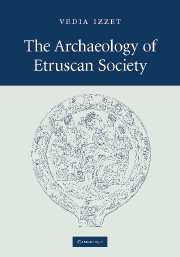Book contents
- Frontmatter
- Contents
- List of illustrations
- Acknowledgements
- List of abbreviations
- Introduction
- 1 Models of change in Etruria
- 2 Etruscan mirrors: reflections on personal and gender identity
- 3 Funerary architecture: the living and the dead
- 4 Sanctuaries: the sacred and the profane
- 5 Domestic architecture: public and private
- 6 Urban form and the concept of the city
- 7 Making Etruscan society: culture contact and (material) culture change
- Bibliography
- Index
3 - Funerary architecture: the living and the dead
Published online by Cambridge University Press: 10 May 2010
- Frontmatter
- Contents
- List of illustrations
- Acknowledgements
- List of abbreviations
- Introduction
- 1 Models of change in Etruria
- 2 Etruscan mirrors: reflections on personal and gender identity
- 3 Funerary architecture: the living and the dead
- 4 Sanctuaries: the sacred and the profane
- 5 Domestic architecture: public and private
- 6 Urban form and the concept of the city
- 7 Making Etruscan society: culture contact and (material) culture change
- Bibliography
- Index
Summary
Introduction
This chapter takes tomb architecture as the starting point for the examination of changing Etruscan attitudes to surface and boundaries from the seventh century to the fifth. It will argue that the surface of the tomb not only marked the physical distinction between inside and outside the tomb, but also formed the interface between the living and the dead. The period under consideration saw dramatic changes in Etruscan funerary monuments: the massive burial mounds (tumuli) of the Orientalising period were characterised by their size and wealth, extending as far as 50 metres in diameter, and containing up to four tombs, each with multiple chambers, all reached by an entrance corridor (dromos); by contrast, the sixth century saw a decrease in the size of funerary monuments and a change from circular to rectilinear monuments that were now arranged in orderly rows.
The reasons for such changes have been thought to be increased foreign contacts, technological advances, restrictions of space, or socio-political considerations. An example of the latter is the interpretation of the stylistic unity of the tombs from the late sixth century on, taken together with their increased number and decreased size. With particular reference to the cemeteries of Cerveteri, this has been seen as the result of the rise of a ‘ceto medio’, or middle class, at the expense of the old elites who had been buried in the large mounds.
- Type
- Chapter
- Information
- The Archaeology of Etruscan Society , pp. 87 - 121Publisher: Cambridge University PressPrint publication year: 2007



